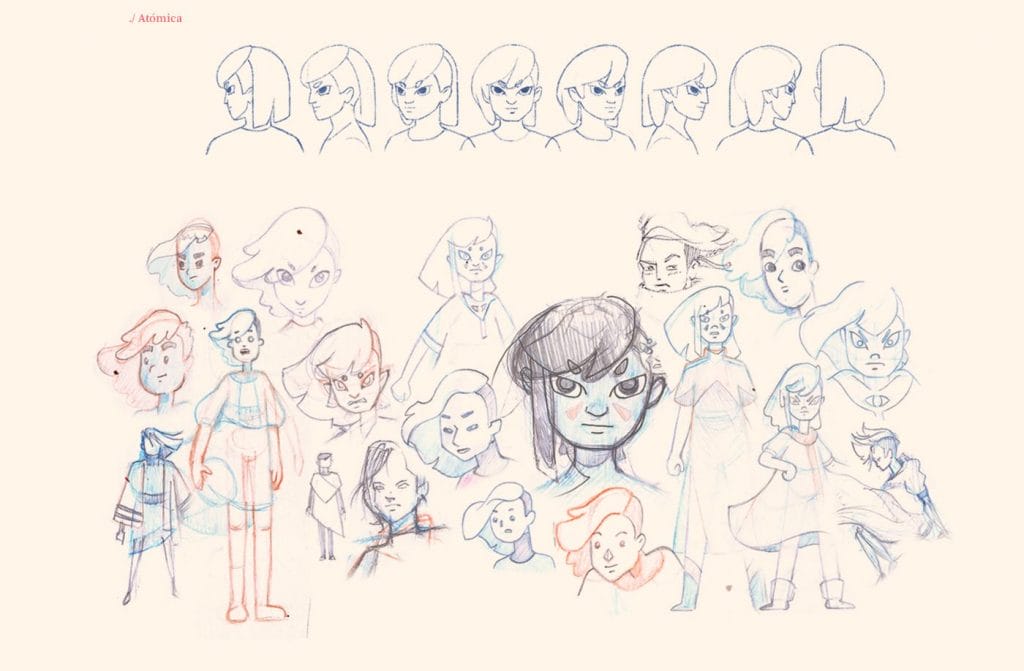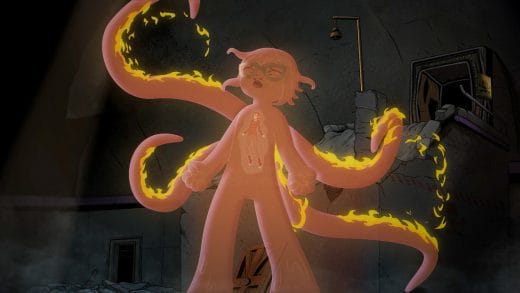
Atómica is an animated music video by KIOSKO, created for the Ecuadorian band, Cementerio de Elefantes. The short follows Atómica as she seeks to find the source of the decay affecting her home, a beautiful and verdant tree. She journeys through otherworldly landscapes in search of the destructive anthropomorphs who are causing havoc to her natural homeland. The film’s creators are a trio of talented animators and illustrators: Facundo Quiroga, Sebastián García, and Juan Nadalino. Started in 2019, Atómica showcases the studio’s sharp 2D animation and unique art style.
The project began with Facundo and Juan spearheading the pre-production, including scriptwriting, storyboarding and animatics, while all three members contributed to the direction and animation. Atómica marks their first collaborative effort as a studio, and as a team they handled all aspects of production, from scriptwriting to animation, utilising Toon Boom Harmony for its frame-by-frame animation tools, vector line clean-ups and diverse colouring capabilities. The animation blends vibrant and stark visuals to represent different story phases. Atómica has been well-received at international festivals and has won several awards.
Toon Boom Animation spoke with all three of the project’s creators, who shared their insights from the process. Facundo, Sebastián and Juan share tips on animating a musical project as well as advice for artists interested in showcasing their work on the festival circuit. For a closer look at this psychedelic and atmospheric animated work, watch Atómica and read our full interview below…
Please introduce the three team members and their roles on the project…
Juan: KIOSKO studio is composed of three members: Facundo Quiroga, Sebastián García, and myself, Juan Nadalino. We are three animators and illustrators specialising in 2D frame-by-frame animation, and Atómica was the start of our collaborative work as a studio.
Atómica began as a project created by Facundo and myself, who handled the pre-production, script, storyboard, and animatics. Facundo then took charge of all the art for the music video, while the direction and animation were carried out entirely by the three of us.
How did this project come about?
Juan: In 2019, we were still working as freelancers in advertising, and we felt the urge to create a non-commercial animation piece to showcase our own ideas. Coincidentally, a friend who is a member of the Ecuadorian band Cementerio de Elefantes was looking for an animated music video for one of their songs.
Thus, Atómica was born as a collaborative project where we had complete freedom to create an animated story from scratch, with our own art and without the limitations of advertising projects.
What has the critical reception been to Atómica?
Facundo: As soon as we finished the music video, it began its journey through festivals around the world with the help of the distribution company Animation 1908. We are very proud to say that it has been selected for several international festivals, and we have even won the award for Best Music Video at some of them! It was also recently featured by Behance where it is receiving a lot of positive comments.
How would you describe the striking art style used in the music video?
Juan: Although we were clear that we wanted to use Atómica as an excuse to showcase our skills as animators and illustrators, the artistic style also evolved based on the production needs.
Facundo: Initially, we thought that drawing the main character with a uniform line and solid colours would simplify the clean-up process. However, this first decision made the art appear flat, and we didn’t want to go down that path. So, we started adding layers of atmosphere and depth to the various scenes. We wanted each shot to be visually striking.
At the same time, the second half of the music video has a rougher, almost sketch-like line and a reduced palette. This was because we were trying to speed up the animation and clean-up times, and at that moment, we realised that the contrast between the colourful, lively beginning and the stark whiteness of death with the appearance of “the anthropomorphs” also worked conceptually.
Sebastián: For all these reasons, we say that the artistic style was built from the production needs while also trying to ensure that the narrative and the visual elements complemented each other. In any case, something that we learned from this project, it’s that regardless of the artistic style, frame-by-frame animation always requires its corresponding amount of work time.
What tools in Harmony helped you to create animation in this style?
Sebastián: The entire music video was animated using Harmony, primarily using frame-by-frame animation tools. We sketched with brushes and then cleaned them up with vector lines. The colouring tools were also fundamental in our process. We took full advantage of the wide range of tools that Toon Boom offers for traditional animation, allowing us to create very diverse and complex scenes.
Juan: In many scenes, the camera movements were done directly in Harmony. Especially in the scene of the crane’s fall, which is one of the most complex, we used all available resources. That scene is entirely animated and composed in Toon Boom Harmony, including visual effects such as blurs and camera movements.
Are there any notable influences on the visual style of Atómica?
Facundo: As animators raised in the ’90s, we have indulged ourselves in expressing our influences from Japanese anime into Atómica, a style that was very prominent in Argentina during those years. We also drew inspiration from Max Leiva’s sculptures and elements of nature. For example, to create the world of Atómica, we researched extensively about the world of fungi, as it was an element that was intended to be present from the beginning. The phrase from the song, “I will find the magic within the chaos,” was a crucial starting point in deciding the style.
How did you decide on the colour palette for Atómica?
Facundo: About the colours, we wanted to clearly mark two moments in the story. A moment full of life with varied and vibrant colours, typical of nature in its fullness; and on the other hand, the bone colour that represents the destruction, decay and death that the antagonists of this animation bring with them.
Juan: We think a lot about the idea that an atomic explosion erases everything and leaves only white and dust. To reinforce that contrast, the colour at the beginning had to be absolutely vivid.

What was the biggest challenge you overcame on the production?
Sebastián: As this was a large project done by only a few people, the biggest challenge was to maintain motivation over time. Despite having little funding and facing a pandemic that slowed us down considerably, we kept going and finished the project.
Juan: It was also a process in which we learned a lot, and along the way we consolidated as a team and created Kiosko.
What is your advice for animators seeking to work on music videos?
Juan: First of all, include a producer in the team! During the Atómica process, we started without much experience and we didn’t imagine that the role of producer could be so important to keep the ideas within a feasible range. By not having someone to fill that role who could plan how the project would be realised, the idea became so complex that it took us years to finish it.
Sebastián: During this time we learned that, especially in music videos, you can make very effective animations, of high quality, in a short time and adapt to different budgets, as long as you plan and optimise resources wisely. Many times a simple idea well executed is much more effective than a complex idea.
Do not underestimate the role of production, and take advantage of the range of narrative resources that the music video format offers to save work time.

How does the music video process differ from animating in other mediums?
Facundo: The existence of a previous musical track is what guides the whole animated piece; both with its rhythm and lyrics, as well as with its own musical aesthetics.
Juan: On the other hand, as we mentioned before, in the music video format there is a lot of freedom to use all kinds of narrative resources. What happens in the video does not necessarily have to respect the temporal structure of a classic story. Visually we are allowed to do anything as long as it is within the universe we are proposing. It is a very flexible format, full of expression, and very suggestive.
Sebastián: The music video clip is an excellent field to explore aesthetics and ideas.
What’s next for you and the team at KIOSKO?
Sebastián: Now we are working on a micro-short film for the Nouns Fest, in which we were selected. We are also in the development stage of a series in co-production with the podcast Radio Ambulante, which tells stories from Latin America from the NPR network in the USA.
Facundo: We want to be increasingly working on our own projects where we can express our own point of view, and we are excited about this transition from animation for advertising to the creation of original content.
- Interested in seeing more? Stream Atómica by Cementerio de Elefantes or support the band on Bandcamp.
- Thinking about your next independent project? Artists can download a free 21-day trial of Toon Boom Harmony.



